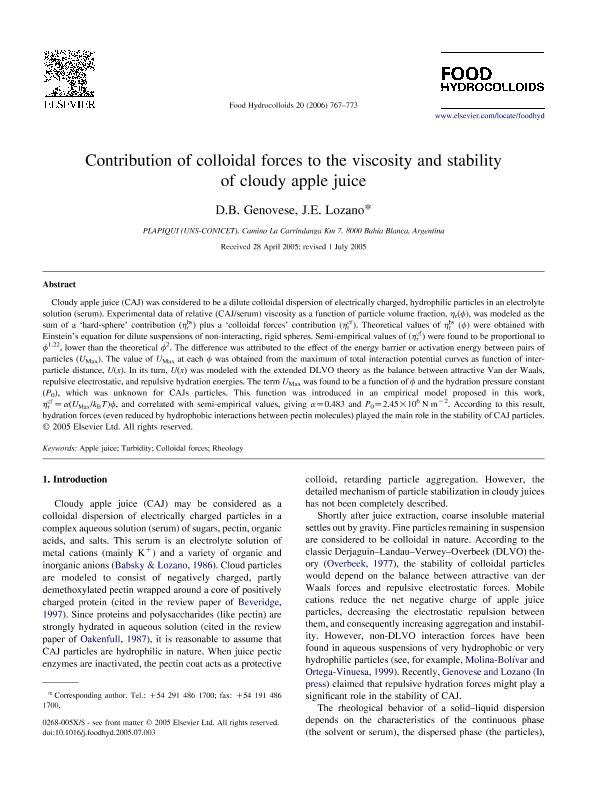Mostrar el registro sencillo del ítem
dc.contributor.author
Genovese, Diego Bautista

dc.contributor.author
Lozano, Jorge Enrique

dc.date.available
2019-07-03T16:08:04Z
dc.date.issued
2006-08
dc.identifier.citation
Genovese, Diego Bautista; Lozano, Jorge Enrique; Contribution of colloidal forces to the viscosity and stability of cloudy apple juice; Elsevier; Food Hydrocolloids; 20; 6; 8-2006; 767-773
dc.identifier.issn
0268-005X
dc.identifier.uri
http://hdl.handle.net/11336/79068
dc.description.abstract
Cloudy apple juice (CAJ) was considered to be a dilute colloidal dispersion of electrically charged, hydrophilic particles in an electrolyte solution (serum). Experimental data of relative (CAJ/serum) viscosity as a function of particle volume fraction, ηr(φ{symbol}), was modeled as the sum of a 'hard-sphere' contribution ( ηr hs ) plus a 'colloidal forces' contribution ( ηr cf ). Theoretical values of ηr hs (φ{symbol}) were obtained with Einstein's equation for dilute suspensions of non-interacting, rigid spheres. Semi-empirical values of ( ηr cf ) were found to be proportional to φ{symbol}1.22, lower than the theoretical φ{symbol}2. The difference was attributed to the effect of the energy barrier or activation energy between pairs of particles (UMax). The value of UMax at each φ{symbol} was obtained from the maximum of total interaction potential curves as function of inter-particle distance, U(x). In its turn, U(x) was modeled with the extended DLVO theory as the balance between attractive Van der Waals, repulsive electrostatic, and repulsive hydration energies. The term UMax was found to be a function of φ{symbol} and the hydration pressure constant (P0), which was unknown for CAJs particles. This function was introduced in an empirical model proposed in this work, ηr cf = α ( UMax / kB T ) φ{symbol}, and correlated with semi-empirical values, giving α=0.483 and P0=2.45×106 N m-2. According to this result, hydration forces (even reduced by hydrophobic interactions between pectin molecules) played the main role in the stability of CAJ particles.
dc.format
application/pdf
dc.language.iso
eng
dc.publisher
Elsevier

dc.rights
info:eu-repo/semantics/openAccess
dc.rights.uri
https://creativecommons.org/licenses/by-nc-sa/2.5/ar/
dc.subject
Apple Juice
dc.subject
Colloidal Forces
dc.subject
Rheology
dc.subject
Turbidity
dc.subject.classification
Alimentos y Bebidas

dc.subject.classification
Otras Ingenierías y Tecnologías

dc.subject.classification
INGENIERÍAS Y TECNOLOGÍAS

dc.title
Contribution of colloidal forces to the viscosity and stability of cloudy apple juice
dc.type
info:eu-repo/semantics/article
dc.type
info:ar-repo/semantics/artículo
dc.type
info:eu-repo/semantics/publishedVersion
dc.date.updated
2019-06-11T19:32:38Z
dc.journal.volume
20
dc.journal.number
6
dc.journal.pagination
767-773
dc.journal.pais
Países Bajos

dc.journal.ciudad
Amsterdam
dc.description.fil
Fil: Genovese, Diego Bautista. Consejo Nacional de Investigaciones Científicas y Técnicas. Centro Científico Tecnológico Conicet - Bahía Blanca. Planta Piloto de Ingeniería Química. Universidad Nacional del Sur. Planta Piloto de Ingeniería Química; Argentina
dc.description.fil
Fil: Lozano, Jorge Enrique. Consejo Nacional de Investigaciones Científicas y Técnicas. Centro Científico Tecnológico Conicet - Bahía Blanca. Planta Piloto de Ingeniería Química. Universidad Nacional del Sur. Planta Piloto de Ingeniería Química; Argentina
dc.journal.title
Food Hydrocolloids

dc.relation.alternativeid
info:eu-repo/semantics/altIdentifier/url/https://www.sciencedirect.com/science/article/pii/S0268005X05001529
dc.relation.alternativeid
info:eu-repo/semantics/altIdentifier/doi/http://dx.doi.org/10.1016/j.foodhyd.2005.07.003
Archivos asociados
